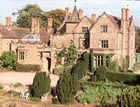House of Memories
This idyllic Staffordshire country house with gardens by Thomas Mawson is on the market for only the third time in its history


According to Savills Research, the average young British family moves house every seven years, which is really rather sad, for it means that fewer and fewer children grow up in the house where they were born. As one who did, Annabel Kidson of Hamptons has only happy memories of her childhood as the youngest of six siblings born and raised at Little Onn Hall near Church Eaton, in the heart of rural Staffordshire.
Her parents, Mr and Mrs Ian Kidson, bought the rambling Victorian house with its 28 acres of gardens and grounds in 1971, shortly after Mr Kidson took over the running of the family book binding firm in Wolverhampton. Now, following Mrs Kidson?s death last year, the house is on the market for only the third time in its history, through Lane Fox (01743 353511), Knight Frank (0121?200 2220) and Savills (01952 239500) at a guide price of £1.7 million.
With its five main reception rooms, 10 main bedrooms, five secondary bedrooms and six bathrooms, Little Onn Hall is an impressive house by any standards, but especially so in a part of Staffordshire which is not overly endowed with classic country houses. In true Edwardian style, a traditional green baize door hides extensive staff quarters with vast cellars below, but the house was never too large for the gregarious Kidson household, Annabel Kidson says, recalling the ?parties for 40 people or more? which regularly took place in her favourite room the panelled dining room overlooking the spectacular Edwardian gardens.
The original hall was built on a medieval moated site in the 1850s by a Col Ashton, passing on his death to his two unmarried daughters. The Misses Ashton embarked with gusto on ambitious plans for improving the house and grounds, as a result of which the Hall almost doubled in size.
The name of the builder who worked on the house appears to have been forgotten, whereas the gardens at Little Onn Hall are part of gardening history.
In the 1890s, the Ashton sisters commissioned Thomas Mawson, one of the most respected garden designers of his time, to produce a detailed plan for landscaping the gardens. His proposals were never fully implemented, as an article in Country Life (April 6, 1989) reveals, ?not because they were unsatisfactory, but because his clients ran short of money?. Having already spent ?in the region of £30,000? mainly on the house the sisters were facing a financial crisis, although they still managed to execute enough of Mawson?s designs to make the gardens at Little Onn Hall among the best examples of his work to be found anywhere in the country.
In that same article, George Plumptre attributes the survival of much of Mawson?s original master plan to ?extensive restoration and replanting? by Mr and Mrs Kidson. Even after her husband?s death in 1998, Mrs Kidson continued to look after the garden with the help of two devoted ?hunkies?, Miss Kidson recalls.
Sign up for the Country Life Newsletter
Exquisite houses, the beauty of Nature, and how to get the most from your life, straight to your inbox.
Thomas Mawson?s legacy at Little Onn includes the terraces along the south and east fronts of the house which, as he explains in his book The Art and Craft of Garden Making (published in no fewer than five editions between 1900 and 1926) were intended ?to give elevation and base to the house?; the splendid water gardens which include an island enclosed by a medieval moat (listed Grade I, but the Hall itself is unlisted); a delightful rustic summer house, built of intricately patterned wood with stained glass windows in the Arts-and-Crafts style which Mawson so admired; and the rose garden, so lovingly maintained and replanted by the Kidsons over the years.
The most unusual ornamental feature of the gardens the so called ?dog ,bone pool? consisting of a narrow canal with larger octagonal areas of water at both ends was not part of Mawson?s plan and was probably added in the 1920s. The Kidson legacy, on the other hand, includes not only the preservation and restoration of Mawson?s work, but some inspirational seasonal planting against the backdrop of towering mature beech trees.
This article was originally published in Country Life magazine, December 8, 2005.


For more on property, architecture, the arts and the countryside subscribe to Country Life magazine

Contact us about this story

Search all online stories

For what's in the magazine this week see contents

Sign up for our free newsletter

Country Life is unlike any other magazine: the only glossy weekly on the newsstand and the only magazine that has been guest-edited by HRH The King not once, but twice. It is a celebration of modern rural life and all its diverse joys and pleasures — that was first published in Queen Victoria's Diamond Jubilee year. Our eclectic mixture of witty and informative content — from the most up-to-date property news and commentary and a coveted glimpse inside some of the UK's best houses and gardens, to gardening, the arts and interior design, written by experts in their field — still cannot be found in print or online, anywhere else.
-
 Two quick and easy seasonal asparagus recipes to try this Easter Weekend
Two quick and easy seasonal asparagus recipes to try this Easter WeekendAsparagus has royal roots — it was once a favourite of Madame de Pompadour.
By Melanie Johnson
-
 Sip tea and laugh at your neighbours in this seaside Norfolk home with a watchtower
Sip tea and laugh at your neighbours in this seaside Norfolk home with a watchtowerOn Cliff Hill in Gorleston, one home is taller than all the others. It could be yours.
By James Fisher